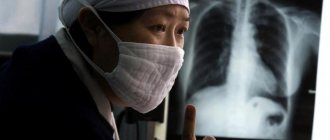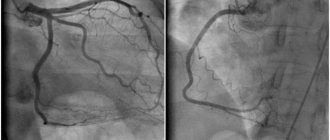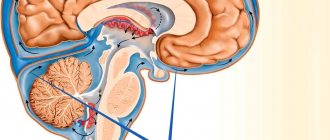Symptoms of acute bronchitis in adults and children
The detailed clinical picture of acute bronchial inflammation includes:
- severe paroxysmal cough;
- discomfort and pain in the chest, especially when breathing;
- wheezing;
- shortness of breath during physical exertion, and sometimes at rest;
- weakness, lethargy, apathy, increased fatigue;
- headache;
- chills;
- increased sweat production;
- increased body temperature (usually no more than 38–38.5 0C).
Acute inflammation of the mucous membrane of the pulmonary tree occurs mainly in winter, when the body's immune defense is weakened and it is easier for infectious agents to penetrate the mucous membranes.
The initial stages are in many ways reminiscent of a common cold. Pathology can be suspected when a dry cough becomes wet with a large amount of sputum. It may be whitish or yellowish - this indicates a catarrhal form of the disease. A green tint indicates the beginning of an active infectious process and a purulent form. Often acute bronchitis (especially infectious) spreads up the respiratory tract. The result is inflammation of the mucous membranes of the trachea, pharynx and nose. The peak of symptoms occurs, as a rule, on the 3rd–4th day of the disease, then the clinical manifestations gradually subside. With timely initiation of competent therapy and a favorable course, after 7–10 days the disease completely disappears, leaving no consequences.
Breathe easily and cleanly! The whole truth about bronchitis
What can unite a person who has had an acute respiratory viral infection, a worker in hazardous production, an allergy sufferer and a heavy smoker?
With questions about such an ailment as bronchitis, we attended an appointment with Galina Pavlovna Grevtsova, a pulmonologist at Clinic Expert Kursk LLC.
- Galina Pavlovna, there are those who have suffered from bronchitis, there are those who have heard or suspect about this disease, but what is it really?
This is an inflammation of the bronchial mucosa.
- What happens to the human body in general and to his lungs, in particular, during bronchitis?
General symptoms are manifestations of intoxication. Bronchitis is characterized by general weakness, increased fatigue, increased body temperature (including up to high numbers, above 38°C), “weakness,” body aches, a feeling of “stuffiness,” and wheezing in the chest.
The leading symptom is a cough, which is quite painful and forces you to seek medical help. At the beginning of the disease, the cough is dry, irritating, and may intensify when inhaling or when talking. It is also called unproductive because it does not produce sputum. There may be discomfort or pain in the chest.
After some time, the cough becomes wet (productive, as it begins to produce sputum). This can happen with or without treatment. The sputum discharge may be mucous and purulent in nature.
If there is a narrowing of the lumen of the bronchi (obstruction), shortness of breath occurs (this symptom is not observed in all patients).
Pulmonary alveoli during bronchitis are not involved in the inflammatory process.
- What is bronchitis in adults and children?
It can be acute or chronic.
Acute bronchitis is a process in which symptoms persist for no more than 3 weeks, and the disease occurs no more than 3 times a year.
In chronic bronchitis, symptoms (in particular, cough with sputum) are observed for more than 3 weeks, episodes of exacerbation or acute bronchitis occur more than 3 times a year.
According to the nature of inflammation, bronchitis can be catarrhal, catarrhal-purulent, purulent, and sometimes hemorrhagic (with the release of streaks of blood and bloody sputum).
In children, chronic bronchitis occurs and is diagnosed less frequently than in adults.
- How is bronchitis different from severe colds and pneumonia?
More common symptoms of ARVI are damage to the upper respiratory tract and pharynx. The cough with it is less prolonged and less painful. There may be a sore throat when swallowing, a sore throat. When listening (auscultation) of the chest, no pathological changes (pathological respiratory sounds) are noted.
With bronchitis - including as a complication of ARVI - the symptoms that we talked about earlier are noted, and pathological breathing sounds are also detected during auscultation of the chest: the so-called “hard breathing” (normally vesicular), dry wheezing.
Pneumonia can also complicate the course of ARVI. With it, the patient's condition is more severe; when listening to the chest, weakening of breathing may be noted, as well as a characteristic sound phenomenon - crepitus. It should be remembered that if the pneumonic focus is small in volume and lies deep in the lung tissue, then it is sometimes impossible to hear signs specific to it.
- Why does bronchitis occur? Can you get bronchitis?
The causes of bronchitis include infections (bacteria, viruses, fungi), allergens, toxic and irritating substances. An interesting example of non-infectious bronchitis is the entry of gastric (!) contents into the lumen of the bronchi. This occurs, for example, with gastroesophageal reflux disease, when in a horizontal position (usually at night), acidic gastric contents enter the esophagus from the stomach, and then flow through the larynx into the trachea and bronchi.
Can you get bronchitis? Yes, if bronchitis is of infectious origin. However, it is more correct to say that you can become infected with the infection that caused bronchitis.
- How to distinguish viral bronchitis from bacterial?
At the stage of examining the patient by a doctor, one can only guess what the exact nature of bronchitis is, i.e. viral, bacterial or some other. However, an accurate diagnosis can only be made after appropriate research, i.e. virological and bacteriological. This could be a study of sputum for the presence of a pathogenic agent, blood for the presence of antibodies to some viruses that can cause bronchitis, etc.
- Why is bronchitis dangerous? Can acute bronchitis turn into chronic bronchitis or asthma?
It is dangerous due to complications. With long-term, untreated bronchitis, the lumen of the bronchi may narrow (due to inflammatory swelling of the mucous membrane) with difficulty passing air through them. Pneumonia may develop.
Acute bronchitis can become chronic. In relation to asthma, it can create a “background”, the prerequisites for its development.
- Galina Pavlovna, how long does it take to treat bronchitis? Is this disease treated in a hospital or can the disease be treated at home?
The duration of therapy depends primarily on the cause of bronchitis. On average, for acute uncomplicated bronchitis it is 10-12 days. He is being treated on an outpatient basis.
Some forms of chronic bronchitis are treated in a hospital. The need for hospitalization is determined by the attending physician.
Despite the fact that in many cases bronchitis can be treated at home, this is not synonymous with self-medication. In any case, you must immediately see a doctor and only then follow his instructions.
-What should a patient with bronchitis never do? For example, can he smoke?
Do not self-medicate (including taking antibiotics; for a dry cough - cough suppressants; uncontrolled use of antipyretic drugs; do not perform physical procedures), do not delay consultation with a doctor.
A patient with bronchitis should not smoke. The reason is simple. Tobacco smoke contains irritating substances, which, in the case of an existing acute inflammatory process, will slow down healing, and in the case of chronic inflammation, will aggravate the pathological process.
- What can be the consequences of bronchitis if left untreated?
It is possible to develop pneumonia, transition to a chronic form, the appearance of increased “reactivity” of the bronchi with greater sensitivity to environmental agents and the subsequent development of bronchial asthma.
- Maybe there are some methods that, if followed, will prevent you from getting bronchitis?
Undoubtedly. Of course, there are no guarantees, but it is quite possible to significantly reduce the likelihood of this disease occurring.
This is, first of all, timely and correct treatment of ARVI under the supervision of a doctor.
It is important to observe a work and rest schedule, get enough sleep, eat rationally, and do physical exercise and sports.
-What should a person who has already been diagnosed with this disease once do? What is the secondary prevention of bronchitis?
Avoid exposure to factors that contribute to the chronicity of the pathological process - first of all, stop smoking.
If a person has been involved in sports, continue exercising.
Breathing exercises, including those within the framework of breathing exercises, are useful.
According to indications, after consultation with a doctor, immunomodulators may be prescribed.
-What specialty should you consult with for symptoms of bronchitis?
If possible, see a pulmonologist. However, in practice, due to the absence of such a specialist at your place of residence, or his high workload, it is not always possible to get to him. In this case, you should contact a therapist or general practitioner.
In our clinic, “Clinic Expert Kursk”, patients with bronchitis are treated by pulmonologists.
For reference:
Grevtsova Galina Pavlovna
Graduate of the Faculty of Medicine of Kursk State Medical University in 2002.
In 2003, she completed her internship in the specialty “Therapy”.
In 2014, she underwent professional retraining in the specialty “Pulmonology”.
Currently working at Clinic Expert Kursk LLC as a pulmonologist.
Read on topic:
What is ARVI?
How to get rid of a barking cough? We're talking about laryngitis
What will help with a cough: badger fat or mustard in socks? We treat children correctly
Symptoms of chronic bronchitis
The chronic form of the disease has a long course with periodic exacerbations. They can be triggered by the same reasons that lead to the development of the primary acute form of the disease. The clinical picture in this case will also be similar. During the period of remission, the chronic form of bronchitis is characterized by shortness of breath even with minor physical exertion. This is the result of constant swelling of the mucous membrane of the bronchi, which means their narrowing and reduction in the volume of air that they are able to pass through themselves. This condition is called chronic obstructive bronchitis (COB).
COB is especially dangerous for young children because their lung capacity is small. A decrease in air flow, insignificant by the standards of an adult, creates serious problems in the systemic gas exchange of the entire body. This leads to a lack of oxygen supply to tissues and organs and, as a result, can result in malformations and general cardiopulmonary failure with disability of the child. In addition, the body’s desire to ensure normal gas exchange in the lungs causes a persistent expansion of the terminal sections of the respiratory tree, that is, leads to the development of emphysema. Therefore, such pathology in young children requires immediate consultation with a pediatrician and early initiation of adequate therapy.
Causes of bronchitis
The bronchi are a paired organ that is a branched tree, the “branches” of which extend into the lungs. Its main function is to transport oxygen from the trachea to the alveoli of the lungs during inhalation and remove carbon dioxide from them during exhalation.
The second function is to purify the air and protect the body from infections and foreign particles (dust, soot, etc.) that enter the respiratory tract along with the air. This is facilitated by the structure of the epithelium, which covers the inner walls of the bronchial tree. This epithelium is called ciliated, since its structure includes cilia that move synchronously in one direction. The cilia constantly vibrate, pushing foreign agents out along with the flow of mucus, which is normally present in the bronchial tubes. In addition to its transport function, mucus also has antimicrobial and antiviral effects. The content of immunoglobulin A, which destroys bacteria and viruses, is ten times higher in mucus than in blood! How well the mucus will perform its protective properties also depends on its rheological properties (fluidity).
After air passes through the trachea and bronchi, it enters the alveoli of the lungs, which are almost sterile.
But the body’s protective function does not always work. Sometimes foreign agents are stronger and penetrate the bronchial mucosa, destroying its cells and causing a response in it - an inflammatory process called bronchitis.
Bronchial tissues swell, its walls thicken, and accordingly, the diameter of the bronchial tube decreases. The body tries to push out the infection by increasing the secretion of mucus and by engaging a protective mechanism such as coughing. But with inflammation, the mucus becomes more viscous, making it difficult to clear.
A decrease in the diameter of the bronchi and the accumulation of viscous mucus in them causes a decrease in their patency, which means difficulty breathing in a person - this is called obstruction.
In the vast majority of cases, the causative agents of the disease are viruses and bacteria - various strains of influenza, parainfluenza, adeno- and rhino-viruses, staphylococci, streptococci, and other pathogens.
It is also possible that the disease may occur due to an allergic reaction of the body. Or due to toxic substances entering the respiratory tract that destroy the bronchial mucosa.
Bronchitis in adults more often develops due to smoking, alcoholism, working in hazardous industries, chronic diseases, and in old age.
What are the causes of bronchitis?
All causes of the disease can be divided into three large categories:
Infectious lesions.
The causative agents may be:
- viruses (adenovirus, influenza virus);
- bacteria (usually strepto-, pneumo- and staphylococci);
- atypical microorganisms such as mycoplasma or chlamydia;
- fungal infections.
Exposure to chemical factors.
These include:
- toxic compounds found in the atmosphere of industrial cities;
- increased content of smoke and/or dust in the air;
- occupational hazards in the form of fumes hazardous to health;
- smoking abuse.
Internal factors.
This is, first of all, individual intolerance to certain substances, manifested by an allergic reaction (inflammation) on the bronchial mucosa. Diseases of the cardiovascular and pulmonary systems, as well as chronic infectious and inflammatory disorders in the nasopharynx, oral cavity and tonsils can also provoke the occurrence of pathology.
Causes of the disease
Typically, bronchitis results from negligence in the treatment of colds and runny nose, as well as the entry of bacteria and viruses into the body. In addition, the disease often develops in smokers and people who work in difficult conditions (forced to inhale dust, fumes and smoke). A decrease in general immunity, stress, poor lifestyle, and constant use of certain types of medications also increase the risk.
There are also anatomical features that can cause a predisposition to the disease. For example, if the lumens of the bronchi are narrow, then even minor inflammation contributes to the accumulation of secretions that fill them, and this becomes the basis for the development of harmful microorganisms.
What forms are there?
Symptoms and treatment of chronic bronchitis depend on how the disease progresses in a particular patient.
The acute form develops very quickly and is characterized by a rapid course and severity of symptoms. Chronic bronchitis most often becomes the result of an untreated acute disease or occurs due to prolonged exposure to provoking factors (for example, smoking or smoke in the atmosphere in a metropolis). The manifestations of the chronic form of bronchitis are more smoothed out, and the course has periods of exacerbation and remission.
Differences between bronchitis and symptoms:
- Cough - in the acute course of the pathology, the symptom occurs suddenly. At first the cough is dry, then it becomes wet and lasts about two weeks. If bronchitis is chronic, the patient may cough for a month or more.
- Difficulty breathing - shortness of breath mainly appears only with a long course of the disease. The acute form, with proper treatment, completely disappears after three weeks.
- Intensity of symptoms - “bright” signs are diagnosed only in patients with an acute course of the disease.
- Temperature – in chronic bronchitis it is normal or not higher than low-grade fever.
The development of chronic inflammation of the lower respiratory tract can be triggered by bacteria, fungi and viruses, as well as some factors that negatively affect the body (inhalation of allergic substances or smoke).
Other types of bronchitis
Inflammation of the bronchi is classified not only according to the form of the clinical course, but also according to other parameters, depending on:
- mechanism of occurrence: primary bronchitis is an independent disease, secondary is a complication of pathologies of other organs;
- level of damage to the pulmonary tree: tracheobronchitis - inflammation of the upper respiratory tract, middle bronchitis and bronchiolitis , in which the pathological process spreads in the smallest respiratory tract (bronchioles);
- character of sputum: catarrhal form with mucous discharge, purulent and mixed variants;
- the presence ( obstructive type) or absence ( non-obstructive type) of gas exchange disorders in the lungs.
Diagnosis and examination for bronchitis
When making a diagnosis, take into account:
- patient complaints (cough, difficulty breathing, high temperature, etc.);
- examination data - hard breathing, scattered wheezing;
- data from instrumental methods: radiography (expansion and blurring of the roots of the lungs, absence of signs of pneumonia);
- data from a general blood test with a leukocyte formula - leukocytosis with a predominance of neutrophils with a shift to the left, accelerated ESR, increased eosinophils with an allergic component;
- sputum culture data (the pathogen and its sensitivity to antibacterial agents are determined);
- biochemical blood test data to determine the degree of inflammation (total protein, C-reactive protein, protein fractions);
Additionally, if necessary, a respiratory function test (spirometry, peak flowmetry), examination of the bronchi using a bronchoscope (bronchoscopy), ECG, and computed tomography are prescribed.
Expert opinion
Bronchitis is one of the most common diseases.
According to some data, more than 5% of the world's population suffers from acute bronchitis at least once a year. Chronic bronchitis lasts noticeably longer and produces more complications. In Russia, chronic bronchitis occurs in 10-20% of the country's population.
In order to reduce the risk of developing complications of both acute and chronic bronchitis, you need to consult a doctor at the first symptoms of the disease. When treating bronchitis, pulmonologists at SM-Clinic are guided by the clinical recommendations of the Russian Respiratory Society, approved by the Ministry of Health of the Russian Federation and use modern effective techniques and drugs.
Alexey Mikhailovich Bankov, pulmonologist at SM-Clinic in Ryazan
Treatment of chronic bronchitis in adults and children in medical
Treatment of acute bronchitis depends on the cause.
- For a bacterial infection, the patient is prescribed antibiotics: systemic drugs (usually in tablet form) or local ones, for example, for inhalation.
- When the disease is viral in nature, it is usually limited to immunostimulants and general adaptogens.
- If the pathology is caused by chemical compounds or individual intolerance to any substances, further contact with toxins or allergens is excluded.
- Symptomatic therapy consists of taking anesthetics, anti-inflammatory drugs, monitoring body temperature and drinking plenty of warm water. Drugs that thin sputum and stimulate its excretion are also widely used.
Treatment of chronic bronchitis outside of exacerbation is a more complex and lengthy task. First, all nearby foci of infection in the patient’s body are identified and eliminated, the oral cavity is sanitized and the immune system is supported. The most important point (especially in children!) is improving airway patency in the obstructive form of the disease. For this, drugs are prescribed that relax the muscles of the bronchi and dilate them, expectorants and mucolytics. Corticosteroids are used to relieve inflammatory reactions. Physiotherapeutic procedures, physical therapy and drainage massage also have a good effect.
Why is bronchitis dangerous?
Treatment of bronchitis in adults and children should be carried out under medical supervision. If the disease is relatively mild, many people endure it “on their feet” without seeking qualified help. However, this approach is fraught with the development of complications. Complications also arise if the patient has severe chronic diseases or reduced immunity.
Main types of complications:
- pneumonia;
- obstructive pulmonary disease;
- sepsis.
Treatment of acute bronchitis helps prevent the development of chronic bronchitis. If the therapeutic regimen is chosen correctly and the therapist’s recommendations are followed, the patient’s health is usually completely restored within about two to three weeks.
Sources
- Chronic non-obstructive bronchitis / T.A. Mukhtarov, A.V. Tumarenko, V.V. Skvortsov // Nurse. — 2015 — No. 8.
- Tatochenko V.K. Respiratory diseases: a practical guide. - M.: Pediatrician. — 2012.
- Jefferson T., Jones MA, Doshi P., et al. Neuraminidase inhibitors for preventing and treating influenza in healthy adults and children // Cochrane Database Syst Rev. - 2012; 1.
- Pharmacotherapy of acute bronchitis/ Benz T.M. — 2021.
- Patrusheva Yu. S., Bakradze M.D., Kulichenko T.V. Diagnosis and treatment of acute bronchiolitis in children: Diagnostic issues in pediatrics. - 2011. - T.Z, No. 1.
- Maznev, N. Asthma, bronchitis and other respiratory diseases / N. Maznev. — M.: House. XXI century, Ripol Classic, 2011.









